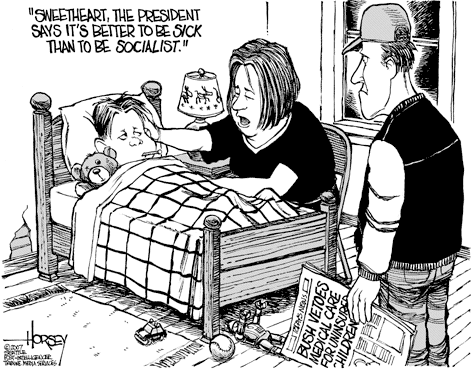Sorry Kids, You’re SCHIP Out of Luck
Those of you who follow U.S. news know what SCHIP is; for those of you who don’t, here’s the intro paragraph from its Wikipedia entry:
The State Children’s Health Insurance Program (SCHIP) is a national program in the United States which was founded by Senator Ted Kennedy and First Lady (now a senator from New York) Hillary Rodham Clinton. The program provides health insurance for families who earn too much money to qualify for Medicaid, yet cannot afford to buy private insurance. The program was created to address the growing number of children in the United States without health insurance. At its creation in 1997, SCHIP was the largest expansion of health insurance coverage for children in the United States since Medicaid began in the 1960s. The statutory authority for SCHIP is under title XXI of the Social Security Act. A proposal recently passed in the Congress to expand SCHIP from $5 billion yearly by $35 billion over five years was vetoed by George W. Bush. The veto follows changes of program administrative rules in August which make it more difficult for states to expand eligibility.
Here’s an editorial comic passed to me by my friend Miss Fipi Lele…

…and here’s last night’s Colbert Report segment, in which they explain SCHIP (and what happened to it) to kids.
Can’t see the video? Click here.
Wikipedia cites a number of studies on SCHIP:
In 2007, researchers from Brigham Young University and Arizona State found that children who drop out of SCHIP cost states more money because they shift away from routine care to more frequent emergency care situations. The conclusion of the study is that an attempt to cut the costs of a state program could create a false savings because other government organizations pick up the tab for the children who leave SCHIP and later need care. In a 2007 analysis by the Congessional Budget Office, researchers determined that “for every 100 children who gain coverage as a result of SCHIP, there is a corresponding reduction in private coverage of between 25 and 50 children.” The CBO speculates this is because the state programs offer better benefits and lower cost than the private alternatives. A Cato Institute briefing paper estimated the “crowding out” of private insurers by the public program could be as much as 60%. The program cost $40 billion federal dollars over 10 years.
I’m always wary of things that begin with “According to a study by the Cato Institute” when they’re about things outside the scope of individual liberties. I understand why their hackles get raised when someone says “I’m from the government, and I’m here to help”, but there are also a number of reasons to be wary when someone says “I’m here from the private sector, and I’m here to help” as well.
Recent Posts
Sunday picdump for Sunday, November 2
It’s Sunday, and it’s time for another “picdump!” Here are the memes, pictures, and cartoons…
Tampa Bay food banks and restaurants where kids eat for free [Updated Monday, November 3]
SNAP — short for Supplemental Nutrition Assistance Program and formerly called “food stamps” — provide…
Sunday picdump for Sunday, October 26
It’s Sunday, and it’s time for another “picdump!” Here are the memes, pictures, and cartoons…
Sunday picdump for Sunday, October 19
It’s Sunday, and it’s time for another “picdump!” Here are the memes, pictures, and cartoons…
Tips for “No Kings” events in Tampa Bay
Here’s some information and advice — but not legal advice, because I’m not a lawyer…
Critical thinking exercise: What’s wrong with this AI slop picture?
For the purposes of this exercise, ignore: Elon’s tendency to exaggerate The idiocy of having…
View Comments